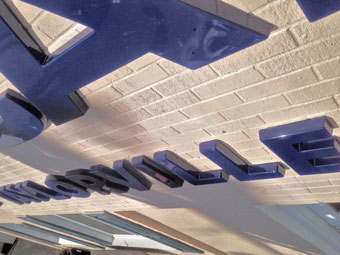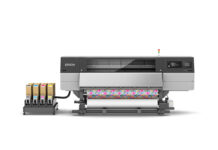When Lilly Signs of Taylorville, Illinois was founded in 1996, owners Jason Lilly and his wife Val started noticing that many of their customers were coming in requesting signs just like the ones they were seeing around the area—in particular, those of the dimensional variety!
With this in mind, they knew that they had to jump into being able to manufacture these types of signs, in order to take advantage of this increased demand for dimensional.
Today this four-person, full-service shop is still going strong and still producing dimensional signs to meet demand.
(Note: Jason and Val have since added two designers to their staff—a wrap specialist and a laser specialist.)
“We started out installing formed, injection-molded, cast/flat-cut plastic, or metal dimensional letters,” says Jason. “We have since moved on to expanded foam. We really like this material for monument signs, because of its versatility and durability.”
Fabrication
One of Jason’s favorite aspects of working with foam is that it is easy to cut, route, or shape the material to accommodate raised or recessed lettering and logos.
In fact, Lilly Signs has plenty of equipment on hand in their shop to help them accomplish these tasks.
Their main piece of hardware is a large bed CNC router, but they also have a Samson 5-by-10 plasma cutter table that they’ve attached to it.
They also use a hot wire foam cutter that melts off pieces of the foam into desired shapes and recesses.
In addition, they like adding extra enhancements to their clients’ monument signage whenever they can.
“We have applied plastic or metal shapes, as well as other accents, to make each customer’s sign unique,” says Jason. “In fact, LED lighting components have made high-density urethane and other composite dimensional signs and monuments much easier to illuminate and to add accents—such as haloed and recessed lighting effects or even integration of LED message centers.”
(Note: Jason says that adding LED technologies to a traditional monument sign can give said sign a modern upgrade, while saving on power.)
Design
When it comes to designing monument signage, Jason finds that foam is a great medium to work with, compared to other substrates.
“You can make it look any way you want,” says Jason. “You can match the brick or stone (faux masonry) of a building without having to hire a mason.”
The first step in the company’s design process is to ensure readability of the sign.

“We always like to take/have location photos to understand the intended [environment] for the sign—whether it will be in front of a building or near the road,” says Jason.
“We also take colors into consideration,” says Christine Condon, a designer/fabricator/installer at Lilly Signs. “Many times, this is up to the customer’s logo colors. So we try to use the colors they want us to use.
“However we always suggest to them that it have at least a 50 percent contrast, so older people will be able to read it as well.”
After accumulating this information, Lilly Signs goes into planning how to build the dimensional sign, as well as the size that will be required for it to be most effective and have the greatest visibility.
“Most towns or cities have sign ordinances though, which often limit or determine the ultimate size of the signage,” says Jason.
Before beginning to design any dimensional signage, Lilly Signs always collaborates with the client first.
“We find out what they are looking for, what kind of budget they need to stay within, and whether or not they want something illuminated or just spot-lighted,” says Jason.
And don’t think that you are just limited to a 2D playing field when it comes to a customer requesting vinyl.
“We like to use stand-offs,” says Christine. “We recently had a customer come in wanting a vinyl-decorated panel office sign, but we attached it to Plexiglas® and added stand-offs to it to make it come off the surface. It worked beautifully!”
Lilly Signs also likes to use different types of aluminum, such as brushed silver aluminum.
“You can put clear on it to give the print on it a little more dimension and add Plexiglas layers and standoffs to it,” says Christine.
When it comes to adding coatings and finishes to their foam signs, the shop uses Matthews Paint two-part paint and catalyst. “It dries smoother,” says Jason. “If we’re rolling it on, it doesn’t leave roll marks. If we’re brushing it on, it doesn’t leave any brush marks.
 “It comes out really nice.”
“It comes out really nice.”
Tools of the Trade
Finally no dimensional sign project is ever complete without the right equipment and tools.
The first step, says Lilly, is to make sure you know the type of surface or material that the sign is being installed on.
For example, the surface might be brick, wood, drywall, dryvit, cement block, vinyl siding, or ribbed steel.
“Knowing the surface and location beforehand will help you reduce the installation time later and aid in determining which materials you should use to fabricate your dimensional signage,” says Jason.
By Lori Shridhare
Photos: Lilly Signs











